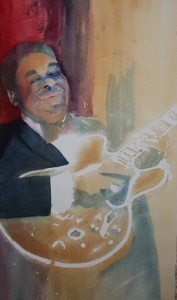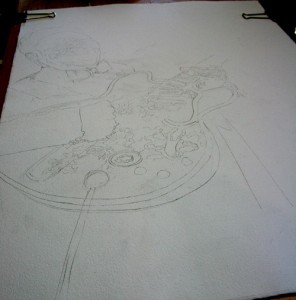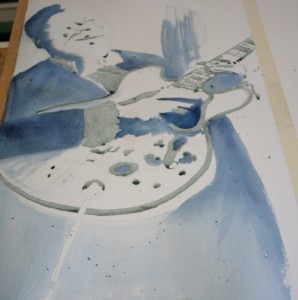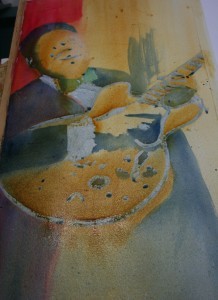Chris Rogers's Blog, page 18
August 9, 2015
3 from BVAL in Splash 16 – What Joy!
When my copy of Splash 16: the Best in Watercolor – Exploring Textures arrived in the mail, I wasted no time flipping through to my own modest offering on page 12. Yes, I was a little dismayed–aren’t we always?–to find the seascape, My Turn, occupying only a half page compared to the full-page presentation a similar painting was awarded in last year’s The Artistic Touch 6. Fortunately, I share space with an awesome watercolorist, Elizabeth Larowe, whose seascape was painted on Yupo paper. 
I don’t know Elizabeth, but what joy to discover as I leisurely flipped through the remaining pages a piece by Hailey Hererra. Serenity Koi, her watercolor with sumi ink and watercolor pencil, appears on page 42 (a well deserved full page). Hailey resides in Bryan-College Station, the closest “big city” to where I live, and I’ve admired her work in local galleries for years.
Then: more joy when I discovered Abandoned by Monika Pate on page 115. Monika’s photo-realistic still life paintings tend to mesmerize me, but this one more than usual. Not a gathering of lovely items from a home but discards most likely collected from a junk yard–and brilliantly executed in watercolor.
Having recently joined the Brazos Valley Art League (BVAL), I can humbly boast that I know these and other amazing member artists. If you love art and haven’t see the Splash series edited by Rachel Rubin Wolfe, the books are available on line or in art supply stores. Pick up a copy, but please start with Splash 16.
July 28, 2015
Today I Killed a Brown Recluse
No, I didn’t hit it with my car, but the car was involved. This was my day to wash it.
So I’m gaily swiping on the suds, listening to a creepy story by Richard Matheson – the Prince of Creepy Stories – one that Alfred Hitchcock produced many years ago. Anyway, I wouldn’t have recognized the Brown Recluse if my grandson Matthew hadn’t been bitten by one while working in my garden a few months ago. Much misery followed, including a trip to the ER, staff infection, and scars.
I use yellow microfiber cloths to wash the car, and there it was, crawling across the sudsy rag.
Now, I’ve killed people before, and even animals occasionally, in my own stories. It comes with being an author who dotes on mystery-suspense-science fiction-paranormal ventures. I’ve also killed spiders without ever knowing their names. I don’t get friendly with the flies I kill, either.
Honestly, it kind of bothered me to step on that little guy. They’re rather puny and won’t actually bite unless they feel attacked. But they like to travel up inside your clothing. Then when you bend over or sit down, there’s a little pinch. Only later do you realize the consequences of that pinch. Ouch, Matthew!
I’ve been rattled out of bed by the sting of a centipede, and wasps often attack me when I’m trimming shrubs. The bite of a Brown Recluse is a thousand times worse. So I mourned him for only a second or two while I washed him down the drain.
And my 2003 Toyota, which boasts 252,000 miles so far, got its wash. I won’t feel guilty at all spending the rest of my day painting.
July 13, 2015
When It’s Not Quite Right – Working on Another Legend/Another Novel
Whether painting or writing, sometimes we hit a wall. The last time I started over on a painting, it was because I was using the wrong side of my watercolor paper. This time, the paper’s not at fault. It’s all on me.
Having worked too long on getting the likeness and emotional expression just right, I finally realized it was time to call a halt, ditch the disaster and start over. Fortunately, all the lessons learned on that first go steered me in the right direction. The new version came faster, easier. It’s still not finished, but I’m happy with where it’s headed, and it doesn’t look overworked (yet). 
When I’m writing a story, the opening sentence or paragraph often comes fast. Like in Bitch Factor, 1998, my first bestselling novel: “If Betsy had known about the car waiting for her at the curb that morning, waiting for her to step into the intersection, she would have worn the purple shirt.” Or in Rage Factor, 1999: “Cold. Bone piercing cold needled Sissy’s muscles.”
Those openings came quick and easy, as did this one: “The Jag don’t belong here,” Murley was saying, big belly grazing the side mirror as he faced the young cop. “Anybody could see that. Sticks out like a damn poodle at a dogfight.” Spare Change, my first award-winning short story, was published in Alfred Hitchcock Mystery Magazine in June 1996 and republished recently in Death Edge Tales: 7 Nail-Biting Stories of Suspense. http://www.amazon.com/Death-Edge-Tales-Nail-Biting-Suspense/dp/1479254002/ref=sr_1_2?ie=UTF8&qid=1436821439&sr=8-2&keywords=death+edge+tales
In writing Emissary, however, the first book in a trilogy featuring Longshadow, a Houston cop, and Ruell, an emissary from a doomed planet, I finished the book and revised the opening half a dozen times. Yet, after receiving the ARC (advanced reader copy), I still felt compelled to reposition a paragraph from the opening page. This kind of tedious determination can make us crazy. After all, once we finally know what we’re doing, shouldn’t art or writing come easy? http://www.amazon.com/Emissary-Chris-Rogers/dp/1631250051/ref=sr_1_1?ie=UTF8&qid=1436822812&sr=8-1&keywords=emissary+chris+rogers
No. When it comes too easy, that’s when boredom sets in (IMHO) and the work may be put out to an audience before it’s the best it can be. My first novel, Bitch Factor, was completely revised 10 times before I sent it to an agent. Then she had “a few revisions,” which involved two complete rewrites. After my editor at Bantam won the bid and bought the rights to publish it, she said, “Chris, you know I love this book. I have just a few revisions.” Fortunately, every rewrite made it better, and I can read Bitch Factor today without wanting to change a single word.
Sometimes, though, we hit a wall when everything we do seems to be just fidgeting – possibly even making a small problem worse. Is it time to quit?
The novel I’m writing now has turned tedious at the precise point where I must ratchet up the tension and bring the whole story together in a climactic moment. I groan just thinking about it. And the current short story in my queue stopped short when my attention was seized by another exciting idea. Now I can’t recall where it was headed.
Though my studio is filled with half-finished paintings, my story files are not quite so littered. A few seemed wonderful and exciting at first then out before I got to “the end.” In every case, however, I learned valuable lessons that keep me writing and painting.
Occasionally, I decide, “Maybe it’s time to set fire to the whole lot.” Or then again, “Maybe it’s just time to start over with a new perspective.” Starting anew can be a good thing.
Here’s a “first draft” of how the painting above might look once I finish both the watercolor insert and the acrylic background then assemble the pieces – provided I don’t hit another wall. By the way, can you guess the name of this legendary singer? 
July 4, 2015
New Video – Here Lies a Wicked Man
When your 16-year-old son drops in on his new Harley, after not speaking to you for four years, a man can be sure something’s amiss. To find out what’s going on with son Bradley, Booker Krane must refocus his attention away from a murder investigation.
Booker never expected to have a murder laid at his door, anyway. He left Houston and moved to the sticks for tranquility. What could possibly enrage people to murder each other in such a sleepy environment? And how could two equally beautiful but dangerously different women number among the suspects? And how could it happen that Booker would lose his heart to a woman who might be a murderess?
While unraveling the puzzle of Chuck Fowler’s death, Booker learns that quite a number of people are neither surprised nor particularly sad about it. Apparently, the late unlamented had a habit of bullying his sons, browbeating his business partner, and was intent on draining the family bank accounts before divorcing his wife. To top all that, he was known to round up stray dogs for target practice.
In Booker’s opinion, if a man ever needed killing, Chuck Fowler was it. Why not call it an accident, save the county some money, and let everybody get on with living?
Booker might do exactly that except for two pesky problems. He lost his son once by being too busy for what really matters; now he wants Bradley to look up to him again as a hero. And he before he can commit to the woman he loves, he has to know if she’s a cold-blooded killer.

Book Cover:
Here Lies a Wicked Man
June 25, 2015
Remember to Look for the Good Stuff
I was on my knees – again – plucking nutgrass out of the lawn in preparation for mowing. For anyone not familiar with Texas lawns, nutgrass is about as plentiful and as welcome as fire ants. Growing up we called it “sticker burrs.” The only sure way to get rid of nutgrass without harsh chemicals is to pull the heads off before they go to seed then fertilize the lawn like crazy while planting real grass.
Anyway, I’m plucking away when I come across a little gem, just a wildflower that technically is also a weed but I can’t bear to destroy it. I left it there near a couple of its sisters.
While I continued working, my gaze kept flicking back to the small yellow flowers almost lost in the great expanse of green, and I realized it’s so easy to look at a piece of writing or artwork we’re editing and focus only on the problems. Those of us who are natural problem solvers have the worst time of it, but anyone who engages the “editorial mind” while viewing a work in progress is apt to see the flaws and overlook a gem of great prose or the masterful stroke that fills a painting with life.
As we move forward, let’s be gentle with ourselves. Let’s take a moment to appreciate the little things we’ve done that are really pretty great before beginning the seek-out-and-destroy process of dealing with problems.
It’s true that we often learn best from our mistakes, but that tiny gem in a lawn riddled with nutgrass deserved a little love and protection. Don’t our occasional triumphs, however small they might be, deserve similar acknowledgment?
In Progress – What a Difference a Flip of the Paper Makes
When I started this painting, the watercolor of BB King fuzzed out – oops! Wrong side.  Now it’s coming along okay …
Now it’s coming along okay …  but all in all, I believe I’ll stick to Arches paper. Fabriano is a little soft for the sort of work I do.
but all in all, I believe I’ll stick to Arches paper. Fabriano is a little soft for the sort of work I do.
The background is acrylic. Starting with this early stage.  Both pieces are in still in progress, but I’m okay now with what’s happening, as long as I don’t do something to ruin the watercolor portion.
Both pieces are in still in progress, but I’m okay now with what’s happening, as long as I don’t do something to ruin the watercolor portion.
It’s all good until someone spills a cup of coffee.
June 17, 2015
Starting Over – Pfui!
Starting the watercolor painting of B.B. King was my first time to use Fabriano paper. My choices thus far had been Strathmore or Arches, but I’d heard that Fabriano is a quality paper, so when it began falling apart the problem had to be of my own making. Right?
With Arches, you can clearly read the logo – if it’s backwards you’re on the wrong side. Fabriano paper has only a small bird in one corner, embossed or debossed depending on which side you choose. I chose wrong.
The first washes went on fine, but I noticed that removing the masking fluid was more difficult than it should be. Even the broad second washes looked okay. When I added detail, however, the strokes fuzzed out, ruining the image.
Pfui!
Fortunately, my initial drawing was done on tracing paper, so I re-transferred the image – this time using Fabriano with the embossed bird showing, reapplied the mask, and started over. Then stopped.
Doing a thing twice – whether in painting or writing – takes the wind out of my sails. When crafting a story, I’ve done enough rewrites that I learned to muscle on anyway. Very few of my stories remain unfinished forever, unless I determine they simply aren’t going anywhere.
By contrast, my studio contains so many unfinished paintings that I’m embarrassed by the lack of follow-through. Occasionally, I line them up around the room and study each one trying to understand what stopped me from continuing and what I might do to regain my initial passion for the piece. So far, I can’t recall a single painting that I’ve restarted after abandoning it – although I have started over occasionally when a problem occurred while my enthusiasm was still intact.
Momentum is a precious thing. Once lost, I find it so very easy to shift my focus to an altogether new idea. I’m much better at starting than finishing. In this case, momentum vanished when my attention was taken with book signings, dental surgery and getting stranded in Hempstead, Texas for two days when my Avalon overheated.
Life is full of surprises. Today, I committed to moving forward with my watercolor abstract painting of legendary musician B. B. King. We’ll soon see if it goes anywhere.
June 4, 2015
Painting a Legend: B B King
When the Art League of Brazos Valley announced the title of the Member Show opening in September 2015, “Up Close and Personal,” my first thought was how much I depend on music to draw me “up close” and into my writing or painting. Two of my favorite musicians passed recently, blues legend B. B. King and jazz clarinettest Mr. Aker Bilk.
What could be more personal than to paint the joy these musicians brought to me and the emotional power they helped me to infuse in my work? Only by diving in to the task will I know if I can do them justice.
Today, while listening to the bluesy chords of Lucille and the King’s somewhat gravelly voice render my favorite pieces, including “The Thrill is Gone,” I started the first phase of a what will be a 40″ x 30″ multimedia canvas of B. B. King
As I painted, the same joy filled me that I’ve experienced so many times before. The King might be gone, but the thrill of his music will be with us forever.
 Everything starts with a drawing.
Everything starts with a drawing.
 Then I saved the whites with masking fluid.
Then I saved the whites with masking fluid.
Then came the initial watercolor washes:


 Let’s hope the comic quality that appears on his face now, due to the masking fluid blotches, will vanish as I paint the detail in successive washes.
Let’s hope the comic quality that appears on his face now, due to the masking fluid blotches, will vanish as I paint the detail in successive washes.
May 6, 2015
You’ve Heard the Man with a Thousand Voices
But have you seen him? Reading this New York Times account makes me want to see every film in which this actor played a part.
Robert Rietti began his long acting career as child, appearing in Depression-era films and stage productions in his native England, and his career continued into the 21st century when, among other roles, he appeared as an Italian scholar in “Hannibal” (2001), a sequel to “The Silence of the Lambs,” one of the myriad international characters he affected over hundreds of films, plays and radio and television broadcasts.
His career, he often said, was satisfying and rewarding, though he had a fairly serious complaint, which he explained in an interview in the 1990s with the British magazine Empire.
“I get a bit upset when people don’t know I’ve got a face,” he said.
Indeed, Mr. Rietti, who was 92 when he died in London on April 3, was far more often heard than seen. A polyglot with a gift for mimicry, he was a prolific voice dubber, an actor called in to rerecord dialogue in the postproduction phase of making a film.
Perhaps the director was unsatisfied with the sound quality of the original recording and the original actor was no longer available. Perhaps a technical foul-up garbled the sound. Perhaps a foreign actor was deemed incomprehensible in his nonnative tongue. Perhaps the dialogue itself simply needed improving.
Whatever the reason, Mr. Rietti, who became known as “the man with a thousand voices,” was a go-to guy, whose voice emerged from the mouths of hundreds of others in dozens if not hundreds of films.
Among his often uncredited movie contributions, was a Spanish accent he dubbed for the actor Lionel Jeffries in “The Secret of My Success” (1965); he voiced the Russian-accented dialogue in “Doctor Zhivago” for the German actor Klaus Kinski; he mimicked the voice of Orson Welles playing Long John Silver in “Treasure Island” (1971); and he completely redubbed the role of General Marenkov, a Soviet defector, in “Avalanche Express” (1979) when the actor Robert Shaw died before the film was finished.
April 24, 2015
All Our Adventures Lie Ahead – Look for this painting in the KAMU-TV Auction
Sometimes a painting hides in the background until its moment arrives. No one has seen this artwork in person except me, because I moved away from mixed media and on to larger canvases. Now I sort of hate to see it go, but I’m glad it will find a good home.
Today is the day I deliver “All Our Adventures Lie Ahead” to KAMU-TV, our local PBS station. It will be presented in their Super Auction, Monday, April 27 through Friday, May 1, 2015 from 7:00 PM – 10:00 PM. For bidding info, go to: http://auction.tamu.edu/
The Auction can be viewed on:
KAMU-DT ch-12-1 (free off the air HDTV ) DISH 12 & DIRECTV 15
Texas A&M Campus cable ch-4 Texas A&M Campus cable ch-7
College Station/Bryan Suddenlink cable ch-4 College Station/Bryan Suddenlink cable ch-700
Bedias cable ch-9 Brenham cable ch-9
Caldwell cable ch-5 Gause cable ch-7
Hearne cable ch-4 Hilltop Lakes cable ch-4
Iola cable ch-8 Lyons cable ch-10
Madisonville cable ch-8 Navasota cable ch-9
Normangee cable ch-9 North Zulch cable ch-4
Snook cable ch-5 http://auction.tamu.edu/
Here’s the entire painting, unframed;







